Training
Essential steps to complete:
All students must create an account with the following links below before you can enroll into our affiliate Program. You must become Licensed first, then Register your Drones then take the online class. Please make sure you click on the links:
- Create an account using the provided links and obtain a license for operating drones.
- Register your drone
- Enroll in the online class. Our Affiliate Program Lectures are accessible once the fees are paid.
Step by Step
Research and
understand FAA regulations:
Explore the Federal Aviation Administration (FAA) regulations and guidelines for drone pilots. Familiarize yourself with Part 107, which outlines the rules for commercial drone operations.
Select a suitable drone:
Choose a drone that aligns with your goals and meets FAA requirements. Consider factors such as size, weight, and camera capabilities.
Learn the basics of aeronautics:
Gain a fundamental understanding of aeronautics, including concepts like aerodynamics, weather patterns, and airspace. This knowledge is crucial for safe and responsible drone operation.
Apply for
FAA Remote Pilot Certificate:
Submit your application for the FAA Remote Pilot Certificate through the FAA Integrated Airman Certificate and/or Rating Application (IACRA) system.
Insurance and registration:
Consider obtaining insurance coverage for your drone operations and ensure that you register your drone with the FAA, as required by regulations.
Join drone communities:
Connect with other drone enthusiasts and professionals by joining online communities or local groups. Networking with experienced pilots can provide valuable insights and support.
Enroll in an
FAA-approved training course:
Take an FAA-approved training course to prepare for the Part 107 Remote Pilot Certificate exam. These courses cover topics such as airspace regulations, weather conditions, and emergency procedures.
Study for the Part 107 Exam:
Dedicate time to study the FAA Part 107 regulations and guidelines. Practice sample questions and take mock exams to ensure readiness for the official certification test.
Schedule and take the Part 107 Exam:
Once adequately prepared, schedule your Part 107 exam with an FAA-approved testing center. Pass the exam to obtain your Remote Pilot Certificate.
Stay informed and
continuously educate yourself:
Keep abreast of changes in drone regulations and industry trends. Attend workshops, webinars, and conferences to stay informed about the latest developments in drone technology and best practices.
Build a portfolio:
Start building a portfolio showcasing your drone photography or videography skills. A strong portfolio can be instrumental in attracting clients or job opportunities.
Market yourself
and seek opportunities:
Create a professional online presence and actively market your drone services. Look for opportunities to collaborate with businesses, photographers, or agencies that may require drone services.
Embarking on the journey to become a Drone Girl FAA Pilot requires a combination of education, practical experience, and dedication. By following these steps, you’ll be well on your way to a successful and rewarding career as a certified drone pilot.
Course Highlights
Drone Training — Learn what you need to know to become a licensed commercial drone pilot. Instructors are certified by the Federal Aviation Administration (FAA) as licensed drone mapping experts. They break down technical concepts into simple terms.
-
- Drones for beginners
- Aerial photography and videography
- Aerial Mapping and Modeling with Drone Deploy Workshops
- Hands-On Flight Training: Mavic, Phantom, and Inspire
- Basic flight training
- Starting a drone business
- Part 107 Test Prep Course
- Career Training — Gain invaluable career resources. These resources include guidance from women mentors and connections to potential employers. Plus, internships can ensure a seamless transition into the workforce. We’ll help you develop essential job-seeking skills, like how to write resumes and cover letters.
Drone training you’ll learn:
-
- How to fly safely and not worry about violating airspace restrictions or legal boundaries.
- Where you can fly to avoid airspace conflicts and potential hazards.
- How you improve the drone’s performance for specific tasks.
- The quick actions you should take when your drone malfunctions during a mapping.
- How to communicate with air traffic control and other pilots.
- The correct way to read performance metrics, so you know which drone is the best one for the job.
- How you adjust your flying for nighttime or low-light situations.
- And more…
When you have these skills, you can work to improve the world. From wildlife conservation to urban development.
Meet Your Online Aerial Photography Developers

Jerry White
Commercial Airline Pilot & Drone Business Owner
Course Instructor

Kevin Coughlin
Pulitzer Prize Photojournalist
Subject Matter Expert
Career training you’ll experience:
-
- Live Webinars. You’ll have opportunities to chat with accomplished women who work in STEM fields.
- Women Mentorship. For when you want that one-on-one guidance to help you figure out your career options.
- Supportive Networking. You’ll gain connections to professionals, potential employers, and peers during virtual networking events. Networking opens doors to internships and job opportunities.
- Internship Matching. Be exposed to internship opportunities to gain hands-on experience that impresses future employers.
- Entrepreneurship Workshops. If you want to start your drone mapping business, entrepreneurship workshops will help you launch.
Remember… this isn’t just about learning technical skills. It’s about the impact you can make.
Your drone mapping skills will make a difference in people’s lives.
You don’t need to be a tech whiz. With the right guidance, you can become a skilled drone pilot.
Frequently Asked Questions
Q: What equipment do I need for the course?
You can choose a drone that best fits your budget. But we recommend the DJI Mavic 3 Pro. Its superior quality makes creating maps with optimal results.
Q: Which software do you use in your course?
We use a variety of software. These include DJI GS Pro, which is free of charge, and other tools like Drone Deploy and Pix4D. We want you to be familiar with the wide range of options in the drone industry.
Q: Is this course only for those who want to become professional drone pilots?
Not at all! The course will prepare you to become a licensed drone pilot, but it’s also perfect for those who are just curious about drones and mapping. The skills are valuable in various fields.
Q: Will I need to take the FAA Part 107 exam after the course?
Yes, if you want to become a licensed drone pilot. You must pass the FAA Part 107 exam to get your drone license. But no worries, we’ll prepare you to ace the exam.
Q: What happens after I complete the course?
You can consider any career needing people with your drone mapping skills. Our career counseling will help you figure this out.
Q: How long does the course take to complete?
You can progress at your own pace. The course duration depends on the speed at which you’re comfortable learning. On average, students complete the course within 12 weeks, totalling 20 hours.
